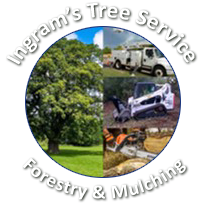Ingram's Tree Service Blog
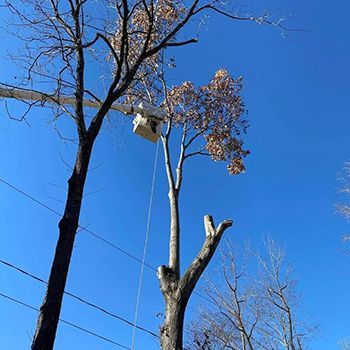
Healthy trees add beauty to your property, but when a tree dies, it can quickly become a safety hazard. A dead tree is more likely to drop branches or even fall over completely, putting nearby structures, vehicles, and people at risk. Identifying a dying or dead tree early can help prevent potential damage and allow for timely removal if necessary. At Ingram’s Tree Service, we can identify dead trees and safely remove them. Here are four signs that a tree is dead. No Leaves or Buds During Growing Season One of the most noticeable signs of a dead tree is the lack of leaves or buds during the growing season. While deciduous trees lose their leaves in the fall, they should sprout new ones in the spring. If a tree remains bare while others around it are flourishing, this is a strong indication that it is no longer alive. Evergreens that turn brown or lose their needles excessively may also be dead or in serious decline. Brittle and Cracking Bark The condition of a tree’s bark can reveal a lot about its health. A healthy tree has a strong outer layer, but when a tree dies, its bark can become brittle and begin to crack or peel away in large sections. If you notice deep cracks or missing bark exposing the inner wood, this is a strong sign that the tree is no longer able to sustain itself. In some cases, you may also see fungi growing on the trunk, which further indicates decay. Fungal Growth and Decay The presence of fungi, such as large mushrooms at the base of the tree or along the trunk, is often a sign of internal decay. Fungi thrive on dead and rotting wood, meaning that if you notice significant fungal growth, the tree may already be beyond saving. In some cases, wood inside the trunk may become soft or hollow, making the tree structurally weak and more likely to collapse. Branches That Are Dry and Break Easily A simple test to check if a tree might be dead is to snap off a small branch. If the branch is dry, brittle, and breaks easily without any green inside, the tree may no longer be living. In contrast, a living tree will have flexible branches with a green layer just beneath the bark. If multiple branches show no signs of life, it’s possible that the entire tree is dead. Tree Removal in High Point, NC When you need tree removal in High Point and the surrounding area, contact Ingram’s Tree Service at (336) 471-4934 . We provide expertise with both residential and commercial tree care in High Point, NC. Feel free to give us a call to arrange a local arborist estimate!
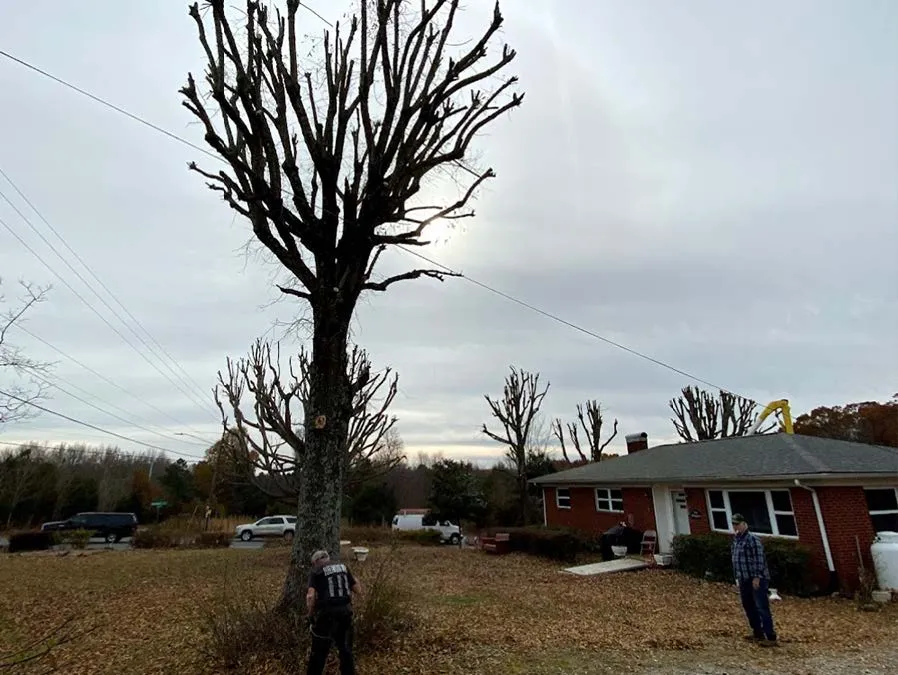
Healthy trees can add beauty and value to a property, but when a tree becomes hazardous, it can pose a serious risk to your home. A compromised tree can cause significant damage during storms or even collapse unexpectedly. Identifying the warning signs early can help you take action before disaster strikes. At Ingram’s Tree Service, we can identify hazardous trees and safely remove them. Here are five signs that a tree near your home may be a danger. Leaning or Unstable Trunk A tree that is noticeably leaning or shifting in its position could be at risk of falling. Although some trees naturally grow at an angle, a sudden lean or an increase in the degree of tilt may indicate root damage or soil instability. If you notice the ground around the base of the tree cracking or lifting, it could mean that the root system is failing to support the tree’s weight. Dead or Dying Branches Large dead branches, especially those overhanging your home, can fall without warning and cause major damage. A tree with multiple dead limbs may be suffering from disease, pest infestation, or internal decay. If a significant portion of the tree appears lifeless and brittle, it may no longer be structurally sound. Cracks or Cavities in the Trunk Deep cracks, holes, or cavities in a tree’s trunk can weaken its overall structure. These issues may be caused by decay, disease, or storm damage. A hollow trunk is especially concerning, as it indicates that the tree’s core strength has been compromised. The arborist can determine whether the damage is severe enough to require removal. Root Damage or Decay A tree’s roots provide stability and nourishment, and when they become damaged, the entire tree is at risk. Construction projects, soil erosion, and fungal infections can all harm root systems. If you notice mushrooms growing at the base of the tree, exposed roots that appear rotten, or a general decline in the tree’s health, it may indicate serious root issues. A tree with compromised roots is more likely to fall, especially during storms. Excessive Leaning After a Storm If a tree suddenly starts leaning after a strong storm, it could be a sign that its roots have been partially uprooted. Even if the tree doesn’t fall immediately, the structural damage may make it unstable. A tree in this condition poses a significant risk, as it may topple with the next heavy wind or rainfall. Tree Removal in High Point, NC When you need tree removal High Point, NC and the surrounding area, contact Ingram’s Tree Service at (336) 471-4934 . Feel free to give us a call to arrange a free arborist estimate in High Point, NC!
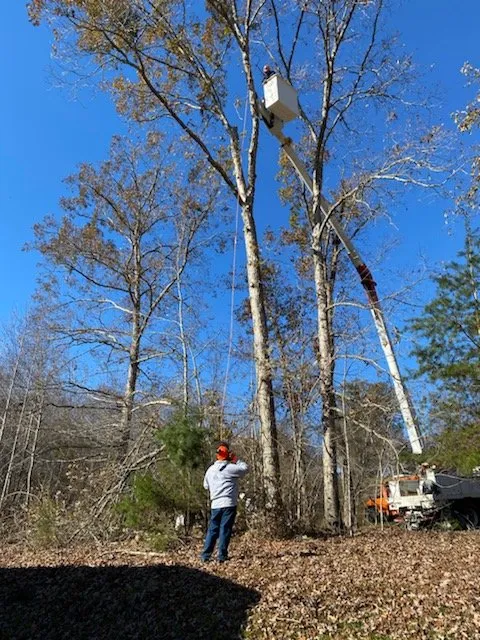
Diseases can weaken trees’ structure, potentially making them unsafe. Recognizing the signs of a diseased tree early can help you take action before the problem worsens. At Ingram’s Tree Service, our local arborists can identify diseased trees and then determine the proper course of action. Here are four signs that your tree may be suffering from a disease. Discolored or Wilting Leaves Healthy leaves are a sign of a thriving tree, so if you notice spotting or wilting, it could indicate a disease. Fungal infections, bacterial diseases, and nutrient deficiencies can cause leaves to turn yellow, brown, or develop unusual patterns. For example, anthracnose is a common fungal disease that can cause brown spots. Unusual Growths/Fungal Presence The presence of fungi, such as mushrooms growing at the base of a tree or on its trunk, can indicate internal decay. Fungal infections weaken the tree’s structure and make it more susceptible to breakage. Cankers, which are sunken or cracked areas on the bark, may also form as a result of fungal or bacterial infections. If you notice any unusual growths on your tree, it’s important to have them evaluated by an arborist. Peeling or Cracked Bark A tree’s bark serves as its protective layer, shielding it from environmental stress and disease. If you notice peeling, cracking, or missing sections of bark, it may indicate a serious problem. Some tree diseases cause bark deterioration as the infection spreads. If large portions of bark are missing or falling off, the tree may be at risk of structural failure. Dead/Dying Branches A healthy tree should have strong, flexible branches that produce leaves in the growing season. If you notice an increasing number of dead or brittle branches, it could be a sign of disease. Sudden dieback, where branches lose leaves and die off quickly, is often caused by infections. If the tree has multiple dead limbs or its crown is thinning, it may not be able to recover without professional intervention. Arborist in High Point, NC When you need an arborist in High Point and the surrounding area, contact Ingram’s Tree Service at (336) 471-4934 . We provide expertise with both residential and commercial tree care in High Point, NC. Feel free to give us a call to ask for a local arborist estimate!
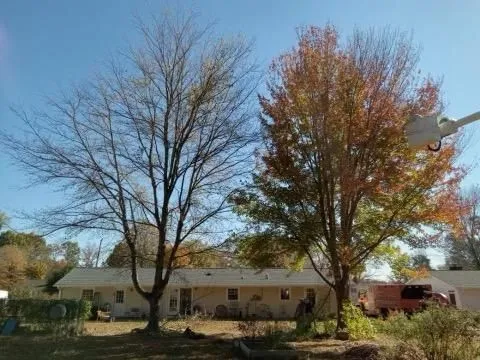
Maintaining healthy trees is essential for preserving their beauty and ecological benefits. Trees are vulnerable to various diseases, but with proper care and attention, you can reduce the risk of infection and help ensure their well-being. If you have any concerns about your trees’ health, our team at Ingram’s Tree Service can conduct an inspection and determine the proper course of action. Here’s a look at five tips for protecting your trees from diseases. Proper Tree Planting Techniques One of the most effective ways to prevent tree diseases begins with proper planting techniques. Trees should be planted in locations that suit their specific soil, sunlight, and spacing requirements. Planting a tree too deep, in poor soil, or in an area with inadequate drainage can weaken its immune system, making it more susceptible to disease. Ensuring the right conditions from the start helps trees establish strong roots and grow healthily. Regular Pruning and Maintenance Pruning plays a critical role in maintaining tree health and reducing disease risks. Removing dead, damaged, or diseased branches helps prevent the spread of infections and allows for better air circulation through the canopy. However, it’s important to prune trees correctly and at the right time of year to avoid causing stress or exposing fresh wounds to disease pathogens. Monitor for Pests and Symptoms of Disease Pests often act as carriers for tree diseases, and their presence can lead to significant damage if left unchecked. Regularly inspect your trees for signs of disease, such as discolored leaves, unusual growths, or bark abnormalities. Early detection allows you to address problems quickly before they become widespread and cause irreversible damage. Water and Fertilize Properly Providing trees with adequate water and nutrients is essential for maintaining their resilience against diseases. Overwatering or underwatering can weaken a tree's immune system, making it more vulnerable to pathogens. Similarly, over-fertilization can stress a tree and invite disease. It’s important to understand each tree's specific needs and maintain a consistent care routine. Hire a Professional Arborist While many homeowners can handle some basic tree care, professional arborists have the expertise to identify early signs of disease, pests, and structural weaknesses. They can provide specialized treatments to address specific issues. Regular professional inspections help ensure trees remain healthy and reduce the risk of serious problems. Arborist in High Point, NC When you need an arborist in High Point and the surrounding area, contact Ingram’s Tree Service at (336) 471-4934 . We provide expertise with both residential and commercial tree care in High Point, NC. Feel free to give us a call to ask for a local arborist estimate!
